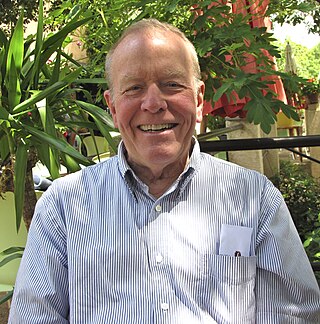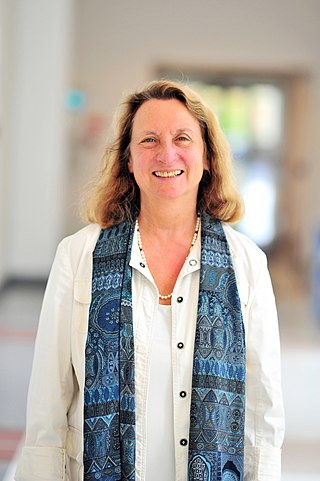Related Research Articles

Combustion, or burning, is a high-temperature exothermic redox chemical reaction between a fuel and an oxidant, usually atmospheric oxygen, that produces oxidized, often gaseous products, in a mixture termed as smoke. Combustion does not always result in fire, because a flame is only visible when substances undergoing combustion vaporize, but when it does, a flame is a characteristic indicator of the reaction. While activation energy must be supplied to initiate combustion, the heat from a flame may provide enough energy to make the reaction self-sustaining. The study of combustion is known as combustion science.

Catalysis is the increase in rate of a chemical reaction due to an added substance known as a catalyst. Catalysts are not consumed by the reaction and remain unchanged after it. If the reaction is rapid and the catalyst recycles quickly, very small amounts of catalyst often suffice; mixing, surface area, and temperature are important factors in reaction rate. Catalysts generally react with one or more reactants to form intermediates that subsequently give the final reaction product, in the process of regenerating the catalyst.

The reaction rate or rate of reaction is the speed at which a chemical reaction takes place, defined as proportional to the increase in the concentration of a product per unit time and to the decrease in the concentration of a reactant per unit time. Reaction rates can vary dramatically. For example, the oxidative rusting of iron under Earth's atmosphere is a slow reaction that can take many years, but the combustion of cellulose in a fire is a reaction that takes place in fractions of a second. For most reactions, the rate decreases as the reaction proceeds. A reaction's rate can be determined by measuring the changes in concentration over time.
Chemical kinetics, also known as reaction kinetics, is the branch of physical chemistry that is concerned with understanding the rates of chemical reactions. It is different from chemical thermodynamics, which deals with the direction in which a reaction occurs but in itself tells nothing about its rate. Chemical kinetics includes investigations of how experimental conditions influence the speed of a chemical reaction and yield information about the reaction's mechanism and transition states, as well as the construction of mathematical models that also can describe the characteristics of a chemical reaction.
CHEMKIN is a proprietary software tool for solving complex chemical kinetics problems. It is used worldwide in the combustion, chemical processing, microelectronics and automotive industries, and also in atmospheric science. It was originally developed at Sandia National Laboratories and is now developed by a US company, Reaction Design.
The Kinetic PreProcessor (KPP) is an open-source software tool used in atmospheric chemistry. Taking a set of chemical reactions and their rate coefficients as input, KPP generates Fortran 90, FORTRAN 77, C, or Matlab code of the resulting ordinary differential equations (ODEs). Solving the ODEs allows the temporal integration of the kinetic system. Efficiency is obtained by exploiting the sparsity structures of the Jacobian and of the Hessian. A comprehensive suite of stiff numerical integrators is also provided. Moreover, KPP can be used to generate the tangent linear model, as well as the continuous and discrete adjoint models of the chemical system.
Keith James Laidler, born in England, was notable as a pioneer in chemical kinetics and authority on the physical chemistry of enzymes.
Khimera is a software product from Kintech Lab intended for calculation of the kinetic parameters of microscopic processes, thermodynamic and transport properties of substances and their mixtures in gases, plasmas and also of heterogeneous processes. The development of a kinetic mechanism is a key stage of present-day technologies for the creation of hi-tech devices and processes in a wide range of fields, such as microelectronics, chemical industry, and the design and optimization of combustion engines and power stations. Khimera with Chemical WorkBench, another software product from Kintech Lab, allows both the development of complex physical and chemical mechanisms and their validation. Essential feature of Khimera is its user-friendly interface for importing and utilizing the results of quantum-chemical calculations for estimating rate constants of elementary processes and thermodynamic and transport properties.
Quantemol Ltd is based in University College London initiated by Professor Jonathan Tennyson FRS and Dr. Daniel Brown in 2004. The company initially developed a unique software tool, Quantemol-N, which provides full accessibility to the highly sophisticated UK molecular R-matrix codes, used to model electron polyatomic molecule interactions. Since then Quantemol has widened to further types of simulation, with plasmas and industrial plasma tools, in Quantemol-VT in 2013 and launched in 2016 a sustainable database Quantemol-DB, representing the chemical and radiative transport properties of a wide range of plasmas.

Reaction Design is a San Diego–based developer of combustion simulation software used by engineers to design cleaner burning and fuel-efficient combustors and engines, found in everything from automobiles to turbines for power generation and aircraft propulsion to large diesel engines that use pistons the size of rooms to propel ships locomotives. The technology is also used to model spray vaporization in electronic materials processing applications and predict mixing reactions in chemical plants. Ansys, a leader in engineering simulation software, acquired Reaction Design in January 2014.
The Geochemist's Workbench (GWB) is an integrated set of interactive software tools for solving a range of problems in aqueous chemistry. The graphical user interface simplifies the use of the geochemical code.
Geochemical modeling or theoretical geochemistry is the practice of using chemical thermodynamics, chemical kinetics, or both, to analyze the chemical reactions that affect geologic systems, commonly with the aid of a computer. It is used in high-temperature geochemistry to simulate reactions occurring deep in the Earth's interior, in magma, for instance, or to model low-temperature reactions in aqueous solutions near the Earth's surface, the subject of this article.
Reactive transport modeling in porous media refers to the creation of computer models integrating chemical reaction with transport of fluids through the Earth's crust. Such models predict the distribution in space and time of the chemical reactions that occur along a flowpath. Reactive transport modeling in general can refer to many other processes, including reactive flow of chemicals through tanks, reactors, or membranes; particles and species in the atmosphere; gases exiting a smokestack; and migrating magma.
Combustion models for CFD refers to combustion models for computational fluid dynamics. Combustion is defined as a chemical reaction in which a fuel reacts with an oxidant to form products, accompanied with the release of energy in the form of heat. Being the integral part of various engineering applications like: internal combustion engines, aircraft engines, rocket engines, furnaces, and power station combustors, combustion manifests itself as a wide domain during the design, analysis and performance characteristics stages of the above-mentioned applications. With the added complexity of chemical kinetics and achieving reacting flow mixture environment, proper modeling physics has to be incorporated during computational fluid dynamic (CFD) simulations of combustion. Hence the following discussion presents a general outline of the various adequate models incorporated with the Computational fluid dynamic code to model the process of combustion.
The SRM Engine Suite is an engineering software tool used for simulating fuels, combustion and exhaust gas emissions in internal combustion engine applications. It is used worldwide by leading IC engine development organisations and fuel companies. The software is developed, maintained and supported by CMCL Innovations, Cambridge, U.K.

Grigoriy Yablonsky is an expert in the area of chemical kinetics and chemical engineering, particularly in catalytic technology of complete and selective oxidation, which is one of the main driving forces of sustainable development.

James Bernhard Anderson was an American chemist and physicist. From 1995 to 2014 he was Evan Pugh Professor of Chemistry and Physics at the Pennsylvania State University. He specialized in Quantum Chemistry by Monte Carlo methods, molecular dynamics of reactive collisions, kinetics and mechanisms of gas phase reactions, and rare-event theory.

Elaine Surick Oran is an American physical scientist and is considered a world authority on numerical methods for large-scale simulation of physical systems. She has pioneered computational technology to solve complex reactive flow problems, unifying concepts from science, mathematics, engineering, and computer science in a new methodology. An incredibly diverse range of phenomena can be modeled and better understood using her techniques for numerical simulation of fluid flows, ranging from the tightly grouped movements of fish in Earth's oceans to the explosions of far-flung supernovae in space. Her work has contributed significantly to the advancement of the engineering profession.
Chemical reaction models transform physical knowledge into a mathematical formulation that can be utilized in computational simulation of practical problems in chemical engineering. Computer simulation provides the flexibility to study chemical processes under a wide range of conditions. Modeling of a chemical reaction involves solving conservation equations describing convection, diffusion, and reaction source for each component species.

Guy B. Marin is professor emeritus of chemical engineering at the Ghent University, Belgium. He is founding member of the Laboratory for Chemical Technology (LCT) and the Center of Sustainable Chemistry (CSC) at Ghent University. Prior to that, he has been teaching at the Department of Chemical Engineering and Chemistry of Eindhoven University of Technology. His research on chemical kinetics and chemical reaction engineering led in 2015 to a spinoff company. He co-authored two books, Kinetics of Chemical Reactions: Decoding Complexity and Advanced Data Analysis and Modelling in Chemical Engineering.
References
1. https://web.archive.org/web/20090108090305/http://www.softscout.com/software/Science-and-Laboratory/Scientific-Modeling-and-Simulation/Chemical-Workbench.html
2. Deminsky, M; Chorkov, V; Belov, G; Cheshigin, I; Knizhnik, A; Shulakova, E; Shulakov, M; Iskandarova, I; Alexandrov, V; Petrusev, A; Kirillov, I; Strelkova, M; Umanski, S; Potapkin, B; et al. (2003). "Chemical Workbench––integrated environment for materials science". Computational Materials Science. 28 (2): 169–178. doi:10.1016/S0927-0256(03)00105-8.
3. Astapenko, M; Bagatur’yants, Alexander; Chernishova, Irina; Deminsky, Maxim; Eletskii, Alexander; Kirillov, Igor; Knizhnik, Andrei; Potapkin, Boris; Rykova, Elena; Umanskii, Stanislaw; Zaitsevskii, Andrei; Strelkova, Marina; Sukhanov, Leonid; Safonov, Andrei; Cotzas, George M.; Dean, Anthony; Michael, J. Darryl; Midha, Vikas; Smith, David J.; Sommerer, Timothy J.; Varatharajan, Bala; Tentner, Adrian; et al. (2007). "First-Principles-Based Development of Kinetic Mechanisms in Chemically Active Light-Emitting Nonthermal Plasmas and Gases". AIP Conf. Proc. 901: 204–2014. doi:10.1063/1.2727370.